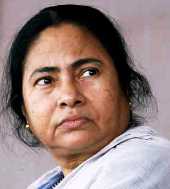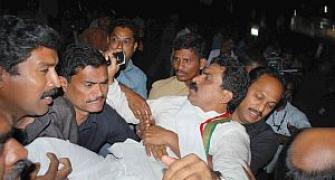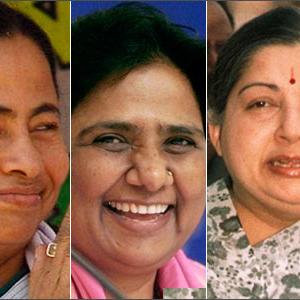 A 'White Paper on Indian Railways' tabled in Parliament by railway minister Mamata Banerjee nailed the lie of the great turnaround by her predecessor Lalu Prasad.
A 'White Paper on Indian Railways' tabled in Parliament by railway minister Mamata Banerjee nailed the lie of the great turnaround by her predecessor Lalu Prasad.
It exposed the farce of bumper profits he showed through jugglery of changes in the accounting system.
Prasad's claim of leaving the cash surplus of Rs 90,000 crore or Rs 900 billion (Rs 88,669 crore or Rs 886.69 billion to be exact) that can take care of all the pending 286 Railway projects, including new lines, doubling and gauge conversion, having the balance funds requirement of Rs 79,462 crore or Rs 794.62 billion, turned out to be far from truth.
He actually left an investment surplus of just Rs 20,208 crore or Rs 202.08 billion with the Railways, after taking into account depreciation and dividends paid to the exchequer. The white paper dubbed his performance as 'below par.'
"Analysis of the overall growth of railways during the period (2004-09) shows that the performance was below par if the normally accepted growth elasticity of 1.25 is reckoned", the white paper said.
Prasad was present in the Lok Sabha when Banerjee tabled the white paper, but he could do little to even protest as the House was already under pandemonium created by the pro- and anti- Telengana members of Parliament from Andhra Pradesh.
The white paper is based on the intensive study and analysis of the Railways' accounts with the help of a reputed consultant (no name given) selected from the list of empanelled audit firms of the Comptroller and Auditor General.
Jaffer the best: Vetting performance of the Railways during the last four railway ministers, the white paper says: "The best period for Indian Railways financially in the last two decades was not the pat five years, but the period 1991-96."
This is a tribute to C K Jaffer Sharief who was the railway minister in the Congress government of P V Narasimha Rao.
The white paper vetted performance on six criteria and the period of Sharief came on the top on five counts, while Lalu Prasad got better off with 2.83 time average dividend to exchequer as against the former yielding 2.50 times.
Of course, Prasad can take pride in performing better than his National Democratic Alliance predecessor and Bihar chief minister Nitish Kumar. The latter could excel over him by 0.04 times in terms of the average block asset turnover.
Average profit margin during Prasad's tenure from 2004 to 2009 was 13.66 per cent as against 15.47 per cent during Jaffer Sharief's period.
Average dividend to exchequer, return on capital employed, block asset turnover ration, employee cost turnover ratio and employee cost coverage ratio were other criteria taken into account.
Unchanged fares created a big hole: Prasad used to take credit of not burdening the rail passengers with increase fare year after year.
The white paper shows that the passenger services run in losses every year during his tenure, shooting up to Rs 13,957.79 crore (Rs 139.57 billion) in the last year of 2008-09.
It was through cross-subsidy from freight traffic that the losses in the passenger segment were compensated.
In freight, growth was mainly on account of the boom in the economy and increased carrying capacity of wagons, though it had a bearing on the wear and tear of tracks and rolling stock, the white paper said.
The document is full of alleged irregularities committed during Lalu Prasad era. It shows how money earned during his tenure was spent or frittered away and not stacked for speeding up pending projects.
It also exposes a variety of hidden charges that found their way into the railway ticketing during his tenure.
Tatkal fraud: For instance, Prasad not only charged exorbitantly for the last-minute 'Tatkal' ticket but raised the percentage of 'Tatkal' seats to total reserved seats from 5.6 per cent in 2005-06 to a whopping14.20 per cent in 2008-09 and thus averaged daily 'Tatkal' earning shoot up from Rs 34 lakh (Rs 3.4 million) to Rs 1.66 crore (Rs 16.6 million) during the period.
Railway's poor punctuality record, re-scheduling of trains, congestions at platforms despite expansion and modernisation of stations, poor on-board catering, lack of cleanliness, ticketless travel and touting and overcrowding of trains are other issues on which Lalu got the flak.
Transparency: The white paper also carries recommendations of the consultant to switch over to the accrual-based commercial accounting as it says accounting in Railways is cash-based in consonance with the government accounting rules which do not give a clear picture of current liabilities and assets in a transparent and understandable to
those outside the government."
It lays stress on a more market-based approach by the Railways to sell its transportation services to the general public, making tariffs competitive and based on accurate costs.
It recommends the accounting to shift from hybrid to accrual system and creation of a new fund for salary and pension arrears in which estimated amount be transferred every year for year-wise adjustment instead of the sudden burden of the Pay Commission arrears.
Pending projects: The document says there were as many as 286 sanctioned projects of gauge conversion, doubling and new lines that required throw-forward (balance funds required) of Rs 79,462 crore (Rs 794.62 billion).
Taking into account the average annual plan expenditure of about Rs 9,000 crore (Rs 90 billion) a year in the last two years, it will take about nine years to complete the projects on hand, though the actual funds needed would be much higher as the figures assessed were based only on rough abstract estimates.
Only 123 of these projects requiring balance funds of Rs 21,505 crore (Rs 215.05 billion) have been identified for taking up on priority on the criteria of growth in traffic and operational considerations.
It will take three to four years to complete all of them and that too at the cost of other projects sanctioned on socio-economic grounds.
These priority projects include 89 doubling of lines, 15 gauge conversions and 19 new lines.
The document shows how many railway projects remain pending for years because of continuous demand in Parliament for new projects.
In the last five years alone, 42 new lines of 4060 km at a cost of Rs 16,693 crore (Rs 166.93 billion) were included in the successive railway budgets.
Other plans: The railway minister also presented a 'Vision 2010' document, which outlines short- and long-term plans of the Railways, which carries 1.8 million passengers every day. It lays down plans for the coming decade.
The tabling of the white paper comes at a time when the government-run behemoth is being confronted with a steady rise in operating cost, which according to senior Railway officials has crossed over 100 per cent, meaning the ministry is spending more than it is earning.
After becoming the railway minister in the second term of United Progressive Alliance, Banerjee had made her intent clear to come out with a white paper on the financial health of the Railways.
Image: Mamata Banerjee








